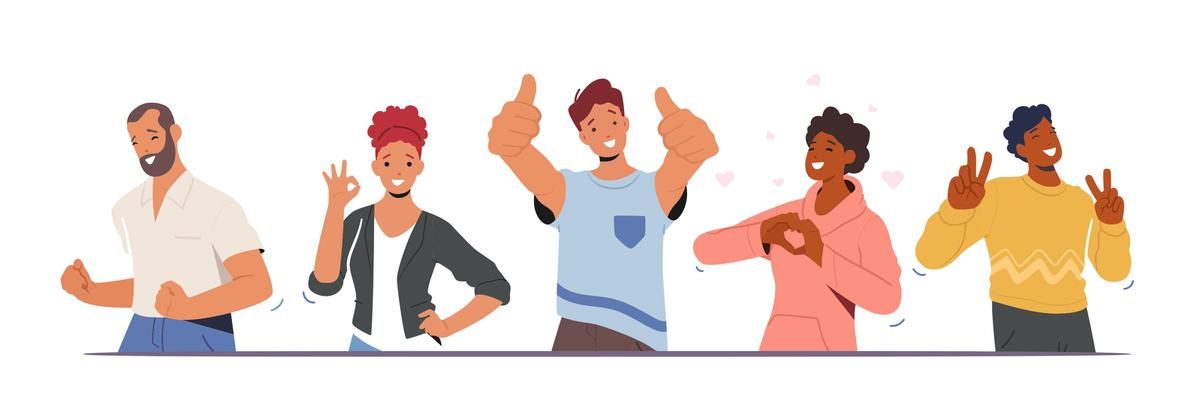A gesture, a smile and eye contact can be the make or break of you.
How we use our body can say a lot about us. If you drop your shoulders and cross your arms, you’ll appear defensive and depressed. Whereas if your shoulders are raised, your head is held high and your palms are open, it suggests the opposite.
Body language itself is a form of communication, and what you communicate with it matters. The non-verbal cues you give can have a damaging effect on how people view you and it, ultimately, can hold you back in your career.
In this article, we’re going to talk you through the different types of body language and why your non-verbal cues are important in the workplace, and we’ll give you some tips to improve your body language to make you more approachable.
Types of body language
First, it’s important to cover the different types of body language that we’re going to be discussing. We’re not just talking about where you put your arms or legs here. It’s much deeper than that. The non-verbal cues you give can include micro-expressions and your gestures, too.
Types of body language include:
- Facial expressions:Our face is highly expressive and can convey a multitude of emotions with just one shift in movement.
- Body posture and movement: How someone sits, stands, walks and holds their head can say a lot about what they’re feeling.
- Eye contact:Eye contact is an important non-verbal communication tool that we all use on a daily basis. It shows sincerity, as well as the ability to show hostility, affection and interest.
- Personal space:Being too close to someone is invading their personal space, and it gives the impression that you’re unperceptive of others’ comfort.
- Gestures:This usually involves hand gestures while you’re talking. It can include waving, pointing, giving the peace sign or calling someone over.
- Touch:Touch is a powerful sense, and how we use touch can say a lot about us. If you give a strong handshake, it shows confidence, while giving a hug can show empathy.
Why it’s important
As we said earlier, how you communicate non-verbally really does matter. If you portray negative body language, you can seem unapproachable — a big no-no in the workplace. If you work on showing positive non-verbal cues, you’re going to be more approachable and make stronger connections with your coworkers and managers.
Body language ultimately shows people what kind of person you are, as it’s an indicator of your enthusiasm, attitude and personality. Your physical actions can actually portray more than words in some situations, so it truly is important to understand how your body language is being perceived by those around you to avoid any miscommunication.
Tips on how to improve your body language in the workplace
Now that you have a solid understanding of the kinds of body language and why it’s important, we’re going to go over some tips to improve it so you’re not giving off any negative vibes.
1. Make eye contact
Eye contact is crucial in forming connections with the person you’re communicating with. It’s what we’re all advised to do when we have a job interview or are dating someone, and this is the reason why.
However, some may argue that “too much” eye contact can seem like you’re trying to dominate someone, while if you avoid eye contact, it makes you appear disinterested and insincere. It’s a fine balance to get it “just right”, as Goldilocks would say. A study in 2016 found that 3.3 seconds is around the “normal” gaze for eye contact, with anything longer making participants feel uncomfortable. So, make sure to maintain eye contact (for a short time!).
2. Stand up straight
Standing up straight while you’re speaking shows the other person that you’re confident and believe what you’re saying. If you’re slouching or turning your body away from the person you’re talking with, it shows a lack of communication skills, as you’ll appear disinterested in what they have to say.
As soon as you enter a room, your posture tells your team members about your approachability, mood and interest. If you want to communicate effectively with people, make sure you’re facing them during your interaction, as it shows that you’re engaged and interested in what they’re saying. This will also increase employee engagement if you’re a leader, as they’ll feel the positivity radiating from your movements.
3. Make sure to smile
As the saying goes: “A smile is the happiness that you’ll find under your nose.” When you smile, you show those around you that you’re happy and receptive to their opinions and ideas. If you spend your day frowning, that makes you unapproachable and this, again, highlights your poor communication skills. Smiling also helps increase productivity, reduce stress and create a healthy work environment that people feel comfortable working in.
While you might not be comfortable with your smile, it’s worth practicing in a mirror so you feel confident. Plus, smiling has been proven to help you live longer!
4. Stay in your personal space
You know that feeling when you’re confined in an elevator with a stranger? It’s uncomfortable, right? That’s because you feel like your personal space is being encroached upon and there’s no escape. Now, put that into the context of an office cubicle. If you’re leaning over into someone’s personal workspace, it can be off-putting (and sometimes downright rude).
Make sure that when you’re speaking with people, you allow an adequate amount of space between you — especially in confined work environments. This will make the other person feel more comfortable, and will also give you the opportunity to observe their non-verbal cues to understand how they’re feeling.
5. Be aware of your hand gestures
In different cultures, certain gestures can be offensive, so it’s worth considering your audience when using certain gestures. For example, if you give someone from, Iran or Iraq a thumbs up, they’ll probably find the gesture insulting. While doing the “okay” gesture is popular in most places, in France it means that someone or something is “worthless”.
When you’re gesturing while speaking, try to use your full hand instead of using a pointer or middle finger (which can be offensive in some cultures). If you’re unsure, ask them if there are any gestures that they find offensive. That way, you’re being inclusive.
Final thoughts
Good communication is vital for your success at work. It’s all about learning how to pay attention to your own body language while also monitoring and assessing others around you. In fact, there are team-building exercises you can do that are based around this topic so you can further understand how non-verbal communication is as powerful as verbal communication — possibly even more so.
Albert Mehrabian, a body language expert in the 1950s, found that the impact of a “message” you send is about 7% verbal (words only), 38% vocal (the tone of voice, inflection, etc) and 55% non-verbal.
So, take some time to actively listen and observe others to see what “message” you’re receiving from them. Are they open to a conversation? Are they feeling a little shy? Do they want to be approached or left alone? When you’re speaking, are they making eye contact and interested in what you have to say? Once you’ve analyzed those around you, you can begin to work on your own body language to portray the message you want to.










